ABPL90335: Comparative Analysis of Construction Contracts
VerifiedAdded on 2022/09/17
|6
|2336
|46
Report
AI Summary
This report provides a comparative analysis of four standard forms of construction contracts: AS4000, ABIC, FIDIC (The Red Book), and NEC4. The comparison focuses on key provisions within each contract, including those related to contract documents (constituent documents, party obligations, discrepancy handling, order of precedence, on-site availability, confidentiality, and intellectual property rights). It also examines progress claims (submission, assessment, and payment processes) and latent conditions, defining them and outlining potential claims. Furthermore, the report investigates provisions for extension of time, detailing conditions for claims, circumstances triggering entitlements, the EOT claim process, responses from the superintendent/contract administrator, other contractual claims, and actions contractors can take to contest decisions. This detailed comparison helps to clarify the similarities and differences between the contracts, providing a comprehensive understanding of their implications for contract management and construction projects. The analysis is structured to address the specific requirements of the ABPL90335 course at the Melbourne School of Design.
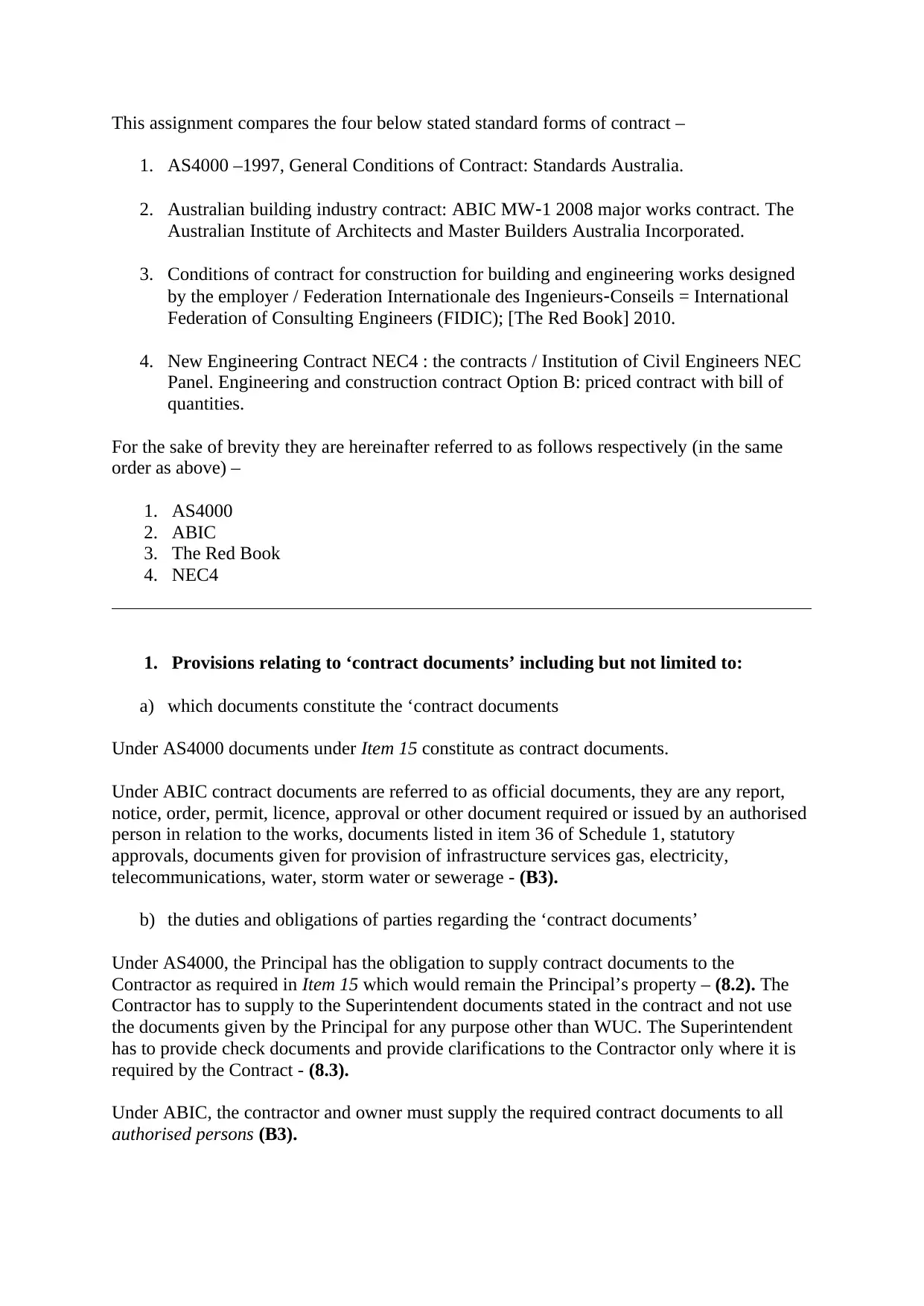
This assignment compares the four below stated standard forms of contract –
1. AS4000 –1997, General Conditions of Contract: Standards Australia.
2. Australian building industry contract: ABIC MW‐1 2008 major works contract. The
Australian Institute of Architects and Master Builders Australia Incorporated.
3. Conditions of contract for construction for building and engineering works designed
by the employer / Federation Internationale des Ingenieurs‐Conseils = International
Federation of Consulting Engineers (FIDIC); [The Red Book] 2010.
4. New Engineering Contract NEC4 : the contracts / Institution of Civil Engineers NEC
Panel. Engineering and construction contract Option B: priced contract with bill of
quantities.
For the sake of brevity they are hereinafter referred to as follows respectively (in the same
order as above) –
1. AS4000
2. ABIC
3. The Red Book
4. NEC4
1. Provisions relating to ‘contract documents’ including but not limited to:
a) which documents constitute the ‘contract documents
Under AS4000 documents under Item 15 constitute as contract documents.
Under ABIC contract documents are referred to as official documents, they are any report,
notice, order, permit, licence, approval or other document required or issued by an authorised
person in relation to the works, documents listed in item 36 of Schedule 1, statutory
approvals, documents given for provision of infrastructure services gas, electricity,
telecommunications, water, storm water or sewerage - (B3).
b) the duties and obligations of parties regarding the ‘contract documents’
Under AS4000, the Principal has the obligation to supply contract documents to the
Contractor as required in Item 15 which would remain the Principal’s property – (8.2). The
Contractor has to supply to the Superintendent documents stated in the contract and not use
the documents given by the Principal for any purpose other than WUC. The Superintendent
has to provide check documents and provide clarifications to the Contractor only where it is
required by the Contract - (8.3).
Under ABIC, the contractor and owner must supply the required contract documents to all
authorised persons (B3).
1. AS4000 –1997, General Conditions of Contract: Standards Australia.
2. Australian building industry contract: ABIC MW‐1 2008 major works contract. The
Australian Institute of Architects and Master Builders Australia Incorporated.
3. Conditions of contract for construction for building and engineering works designed
by the employer / Federation Internationale des Ingenieurs‐Conseils = International
Federation of Consulting Engineers (FIDIC); [The Red Book] 2010.
4. New Engineering Contract NEC4 : the contracts / Institution of Civil Engineers NEC
Panel. Engineering and construction contract Option B: priced contract with bill of
quantities.
For the sake of brevity they are hereinafter referred to as follows respectively (in the same
order as above) –
1. AS4000
2. ABIC
3. The Red Book
4. NEC4
1. Provisions relating to ‘contract documents’ including but not limited to:
a) which documents constitute the ‘contract documents
Under AS4000 documents under Item 15 constitute as contract documents.
Under ABIC contract documents are referred to as official documents, they are any report,
notice, order, permit, licence, approval or other document required or issued by an authorised
person in relation to the works, documents listed in item 36 of Schedule 1, statutory
approvals, documents given for provision of infrastructure services gas, electricity,
telecommunications, water, storm water or sewerage - (B3).
b) the duties and obligations of parties regarding the ‘contract documents’
Under AS4000, the Principal has the obligation to supply contract documents to the
Contractor as required in Item 15 which would remain the Principal’s property – (8.2). The
Contractor has to supply to the Superintendent documents stated in the contract and not use
the documents given by the Principal for any purpose other than WUC. The Superintendent
has to provide check documents and provide clarifications to the Contractor only where it is
required by the Contract - (8.3).
Under ABIC, the contractor and owner must supply the required contract documents to all
authorised persons (B3).
Paraphrase This Document
Need a fresh take? Get an instant paraphrase of this document with our AI Paraphraser
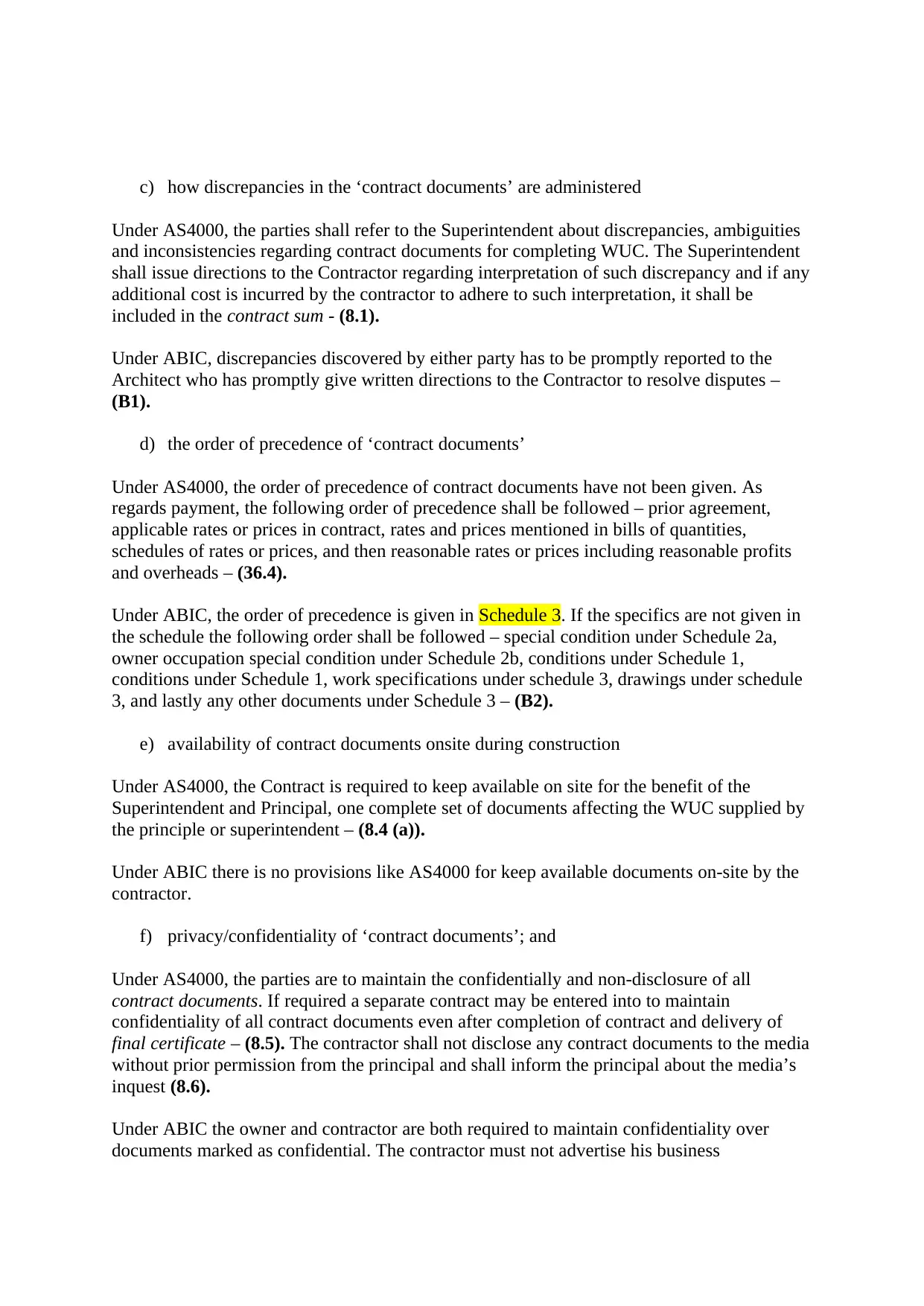
c) how discrepancies in the ‘contract documents’ are administered
Under AS4000, the parties shall refer to the Superintendent about discrepancies, ambiguities
and inconsistencies regarding contract documents for completing WUC. The Superintendent
shall issue directions to the Contractor regarding interpretation of such discrepancy and if any
additional cost is incurred by the contractor to adhere to such interpretation, it shall be
included in the contract sum - (8.1).
Under ABIC, discrepancies discovered by either party has to be promptly reported to the
Architect who has promptly give written directions to the Contractor to resolve disputes –
(B1).
d) the order of precedence of ‘contract documents’
Under AS4000, the order of precedence of contract documents have not been given. As
regards payment, the following order of precedence shall be followed – prior agreement,
applicable rates or prices in contract, rates and prices mentioned in bills of quantities,
schedules of rates or prices, and then reasonable rates or prices including reasonable profits
and overheads – (36.4).
Under ABIC, the order of precedence is given in Schedule 3. If the specifics are not given in
the schedule the following order shall be followed – special condition under Schedule 2a,
owner occupation special condition under Schedule 2b, conditions under Schedule 1,
conditions under Schedule 1, work specifications under schedule 3, drawings under schedule
3, and lastly any other documents under Schedule 3 – (B2).
e) availability of contract documents onsite during construction
Under AS4000, the Contract is required to keep available on site for the benefit of the
Superintendent and Principal, one complete set of documents affecting the WUC supplied by
the principle or superintendent – (8.4 (a)).
Under ABIC there is no provisions like AS4000 for keep available documents on-site by the
contractor.
f) privacy/confidentiality of ‘contract documents’; and
Under AS4000, the parties are to maintain the confidentially and non-disclosure of all
contract documents. If required a separate contract may be entered into to maintain
confidentiality of all contract documents even after completion of contract and delivery of
final certificate – (8.5). The contractor shall not disclose any contract documents to the media
without prior permission from the principal and shall inform the principal about the media’s
inquest (8.6).
Under ABIC the owner and contractor are both required to maintain confidentiality over
documents marked as confidential. The contractor must not advertise his business
Under AS4000, the parties shall refer to the Superintendent about discrepancies, ambiguities
and inconsistencies regarding contract documents for completing WUC. The Superintendent
shall issue directions to the Contractor regarding interpretation of such discrepancy and if any
additional cost is incurred by the contractor to adhere to such interpretation, it shall be
included in the contract sum - (8.1).
Under ABIC, discrepancies discovered by either party has to be promptly reported to the
Architect who has promptly give written directions to the Contractor to resolve disputes –
(B1).
d) the order of precedence of ‘contract documents’
Under AS4000, the order of precedence of contract documents have not been given. As
regards payment, the following order of precedence shall be followed – prior agreement,
applicable rates or prices in contract, rates and prices mentioned in bills of quantities,
schedules of rates or prices, and then reasonable rates or prices including reasonable profits
and overheads – (36.4).
Under ABIC, the order of precedence is given in Schedule 3. If the specifics are not given in
the schedule the following order shall be followed – special condition under Schedule 2a,
owner occupation special condition under Schedule 2b, conditions under Schedule 1,
conditions under Schedule 1, work specifications under schedule 3, drawings under schedule
3, and lastly any other documents under Schedule 3 – (B2).
e) availability of contract documents onsite during construction
Under AS4000, the Contract is required to keep available on site for the benefit of the
Superintendent and Principal, one complete set of documents affecting the WUC supplied by
the principle or superintendent – (8.4 (a)).
Under ABIC there is no provisions like AS4000 for keep available documents on-site by the
contractor.
f) privacy/confidentiality of ‘contract documents’; and
Under AS4000, the parties are to maintain the confidentially and non-disclosure of all
contract documents. If required a separate contract may be entered into to maintain
confidentiality of all contract documents even after completion of contract and delivery of
final certificate – (8.5). The contractor shall not disclose any contract documents to the media
without prior permission from the principal and shall inform the principal about the media’s
inquest (8.6).
Under ABIC the owner and contractor are both required to maintain confidentiality over
documents marked as confidential. The contractor must not advertise his business
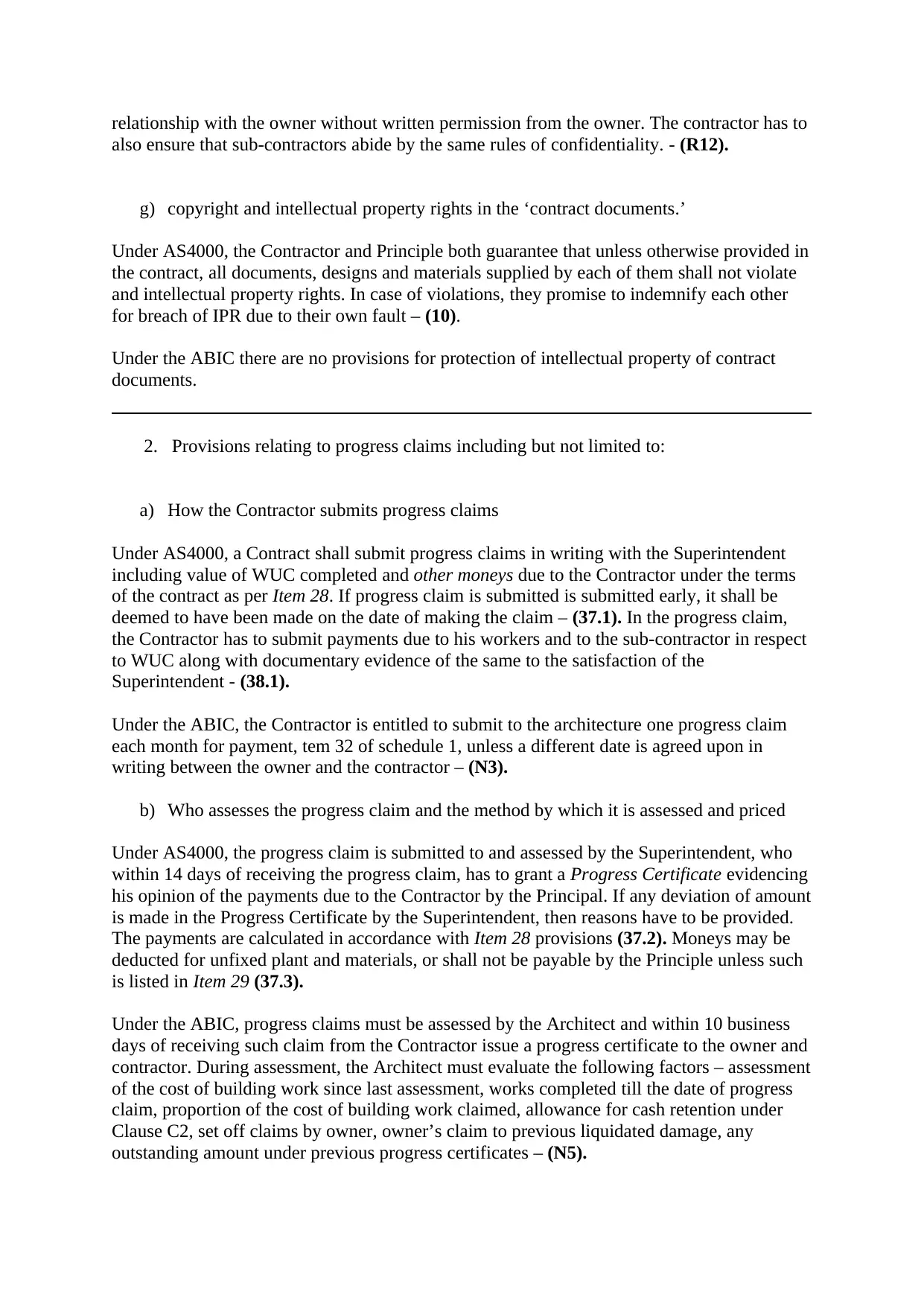
relationship with the owner without written permission from the owner. The contractor has to
also ensure that sub-contractors abide by the same rules of confidentiality. - (R12).
g) copyright and intellectual property rights in the ‘contract documents.’
Under AS4000, the Contractor and Principle both guarantee that unless otherwise provided in
the contract, all documents, designs and materials supplied by each of them shall not violate
and intellectual property rights. In case of violations, they promise to indemnify each other
for breach of IPR due to their own fault – (10).
Under the ABIC there are no provisions for protection of intellectual property of contract
documents.
2. Provisions relating to progress claims including but not limited to:
a) How the Contractor submits progress claims
Under AS4000, a Contract shall submit progress claims in writing with the Superintendent
including value of WUC completed and other moneys due to the Contractor under the terms
of the contract as per Item 28. If progress claim is submitted is submitted early, it shall be
deemed to have been made on the date of making the claim – (37.1). In the progress claim,
the Contractor has to submit payments due to his workers and to the sub-contractor in respect
to WUC along with documentary evidence of the same to the satisfaction of the
Superintendent - (38.1).
Under the ABIC, the Contractor is entitled to submit to the architecture one progress claim
each month for payment, tem 32 of schedule 1, unless a different date is agreed upon in
writing between the owner and the contractor – (N3).
b) Who assesses the progress claim and the method by which it is assessed and priced
Under AS4000, the progress claim is submitted to and assessed by the Superintendent, who
within 14 days of receiving the progress claim, has to grant a Progress Certificate evidencing
his opinion of the payments due to the Contractor by the Principal. If any deviation of amount
is made in the Progress Certificate by the Superintendent, then reasons have to be provided.
The payments are calculated in accordance with Item 28 provisions (37.2). Moneys may be
deducted for unfixed plant and materials, or shall not be payable by the Principle unless such
is listed in Item 29 (37.3).
Under the ABIC, progress claims must be assessed by the Architect and within 10 business
days of receiving such claim from the Contractor issue a progress certificate to the owner and
contractor. During assessment, the Architect must evaluate the following factors – assessment
of the cost of building work since last assessment, works completed till the date of progress
claim, proportion of the cost of building work claimed, allowance for cash retention under
Clause C2, set off claims by owner, owner’s claim to previous liquidated damage, any
outstanding amount under previous progress certificates – (N5).
also ensure that sub-contractors abide by the same rules of confidentiality. - (R12).
g) copyright and intellectual property rights in the ‘contract documents.’
Under AS4000, the Contractor and Principle both guarantee that unless otherwise provided in
the contract, all documents, designs and materials supplied by each of them shall not violate
and intellectual property rights. In case of violations, they promise to indemnify each other
for breach of IPR due to their own fault – (10).
Under the ABIC there are no provisions for protection of intellectual property of contract
documents.
2. Provisions relating to progress claims including but not limited to:
a) How the Contractor submits progress claims
Under AS4000, a Contract shall submit progress claims in writing with the Superintendent
including value of WUC completed and other moneys due to the Contractor under the terms
of the contract as per Item 28. If progress claim is submitted is submitted early, it shall be
deemed to have been made on the date of making the claim – (37.1). In the progress claim,
the Contractor has to submit payments due to his workers and to the sub-contractor in respect
to WUC along with documentary evidence of the same to the satisfaction of the
Superintendent - (38.1).
Under the ABIC, the Contractor is entitled to submit to the architecture one progress claim
each month for payment, tem 32 of schedule 1, unless a different date is agreed upon in
writing between the owner and the contractor – (N3).
b) Who assesses the progress claim and the method by which it is assessed and priced
Under AS4000, the progress claim is submitted to and assessed by the Superintendent, who
within 14 days of receiving the progress claim, has to grant a Progress Certificate evidencing
his opinion of the payments due to the Contractor by the Principal. If any deviation of amount
is made in the Progress Certificate by the Superintendent, then reasons have to be provided.
The payments are calculated in accordance with Item 28 provisions (37.2). Moneys may be
deducted for unfixed plant and materials, or shall not be payable by the Principle unless such
is listed in Item 29 (37.3).
Under the ABIC, progress claims must be assessed by the Architect and within 10 business
days of receiving such claim from the Contractor issue a progress certificate to the owner and
contractor. During assessment, the Architect must evaluate the following factors – assessment
of the cost of building work since last assessment, works completed till the date of progress
claim, proportion of the cost of building work claimed, allowance for cash retention under
Clause C2, set off claims by owner, owner’s claim to previous liquidated damage, any
outstanding amount under previous progress certificates – (N5).
⊘ This is a preview!⊘
Do you want full access?
Subscribe today to unlock all pages.

Trusted by 1+ million students worldwide
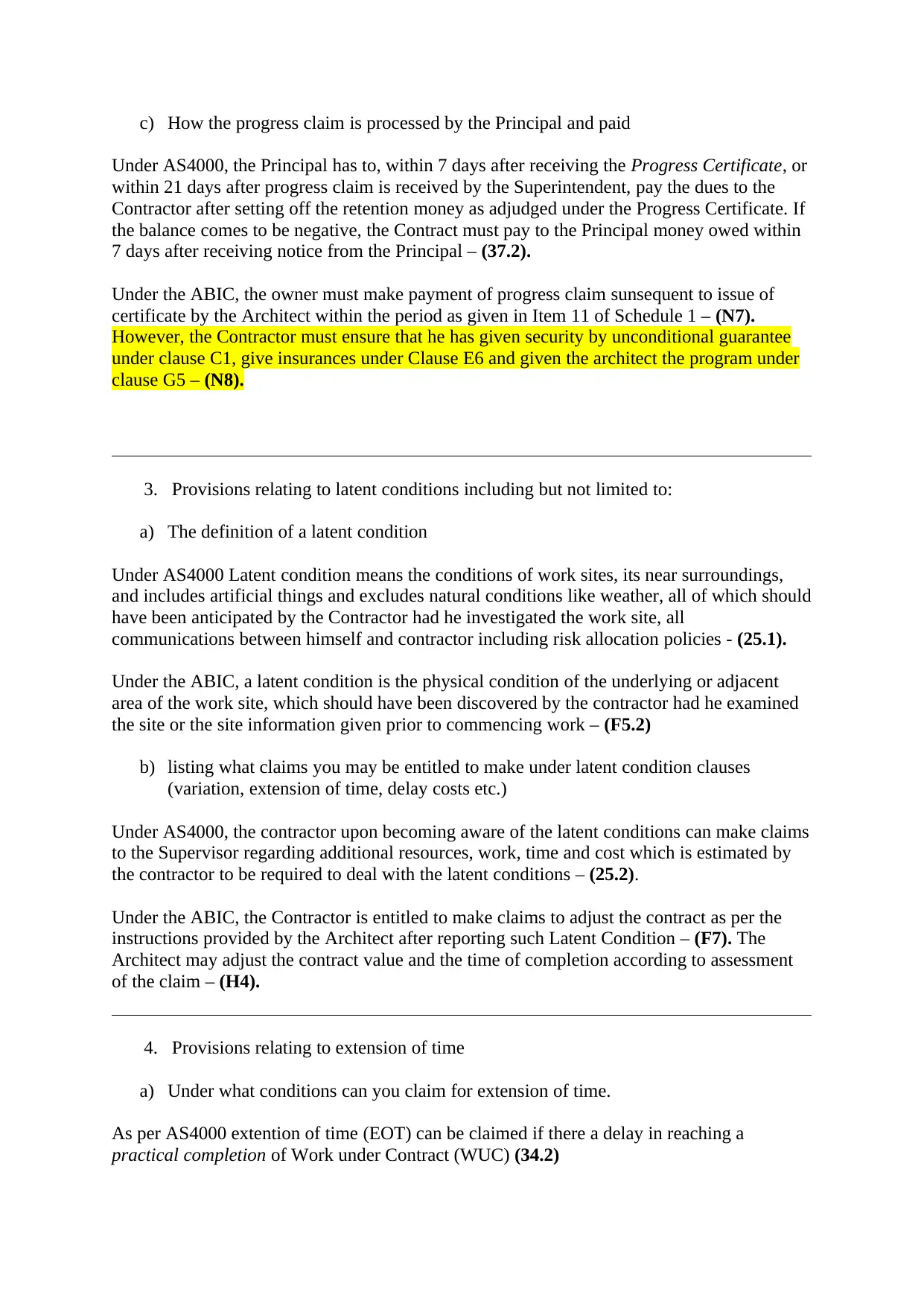
c) How the progress claim is processed by the Principal and paid
Under AS4000, the Principal has to, within 7 days after receiving the Progress Certificate, or
within 21 days after progress claim is received by the Superintendent, pay the dues to the
Contractor after setting off the retention money as adjudged under the Progress Certificate. If
the balance comes to be negative, the Contract must pay to the Principal money owed within
7 days after receiving notice from the Principal – (37.2).
Under the ABIC, the owner must make payment of progress claim sunsequent to issue of
certificate by the Architect within the period as given in Item 11 of Schedule 1 – (N7).
However, the Contractor must ensure that he has given security by unconditional guarantee
under clause C1, give insurances under Clause E6 and given the architect the program under
clause G5 – (N8).
3. Provisions relating to latent conditions including but not limited to:
a) The definition of a latent condition
Under AS4000 Latent condition means the conditions of work sites, its near surroundings,
and includes artificial things and excludes natural conditions like weather, all of which should
have been anticipated by the Contractor had he investigated the work site, all
communications between himself and contractor including risk allocation policies - (25.1).
Under the ABIC, a latent condition is the physical condition of the underlying or adjacent
area of the work site, which should have been discovered by the contractor had he examined
the site or the site information given prior to commencing work – (F5.2)
b) listing what claims you may be entitled to make under latent condition clauses
(variation, extension of time, delay costs etc.)
Under AS4000, the contractor upon becoming aware of the latent conditions can make claims
to the Supervisor regarding additional resources, work, time and cost which is estimated by
the contractor to be required to deal with the latent conditions – (25.2).
Under the ABIC, the Contractor is entitled to make claims to adjust the contract as per the
instructions provided by the Architect after reporting such Latent Condition – (F7). The
Architect may adjust the contract value and the time of completion according to assessment
of the claim – (H4).
4. Provisions relating to extension of time
a) Under what conditions can you claim for extension of time.
As per AS4000 extention of time (EOT) can be claimed if there a delay in reaching a
practical completion of Work under Contract (WUC) (34.2)
Under AS4000, the Principal has to, within 7 days after receiving the Progress Certificate, or
within 21 days after progress claim is received by the Superintendent, pay the dues to the
Contractor after setting off the retention money as adjudged under the Progress Certificate. If
the balance comes to be negative, the Contract must pay to the Principal money owed within
7 days after receiving notice from the Principal – (37.2).
Under the ABIC, the owner must make payment of progress claim sunsequent to issue of
certificate by the Architect within the period as given in Item 11 of Schedule 1 – (N7).
However, the Contractor must ensure that he has given security by unconditional guarantee
under clause C1, give insurances under Clause E6 and given the architect the program under
clause G5 – (N8).
3. Provisions relating to latent conditions including but not limited to:
a) The definition of a latent condition
Under AS4000 Latent condition means the conditions of work sites, its near surroundings,
and includes artificial things and excludes natural conditions like weather, all of which should
have been anticipated by the Contractor had he investigated the work site, all
communications between himself and contractor including risk allocation policies - (25.1).
Under the ABIC, a latent condition is the physical condition of the underlying or adjacent
area of the work site, which should have been discovered by the contractor had he examined
the site or the site information given prior to commencing work – (F5.2)
b) listing what claims you may be entitled to make under latent condition clauses
(variation, extension of time, delay costs etc.)
Under AS4000, the contractor upon becoming aware of the latent conditions can make claims
to the Supervisor regarding additional resources, work, time and cost which is estimated by
the contractor to be required to deal with the latent conditions – (25.2).
Under the ABIC, the Contractor is entitled to make claims to adjust the contract as per the
instructions provided by the Architect after reporting such Latent Condition – (F7). The
Architect may adjust the contract value and the time of completion according to assessment
of the claim – (H4).
4. Provisions relating to extension of time
a) Under what conditions can you claim for extension of time.
As per AS4000 extention of time (EOT) can be claimed if there a delay in reaching a
practical completion of Work under Contract (WUC) (34.2)
Paraphrase This Document
Need a fresh take? Get an instant paraphrase of this document with our AI Paraphraser
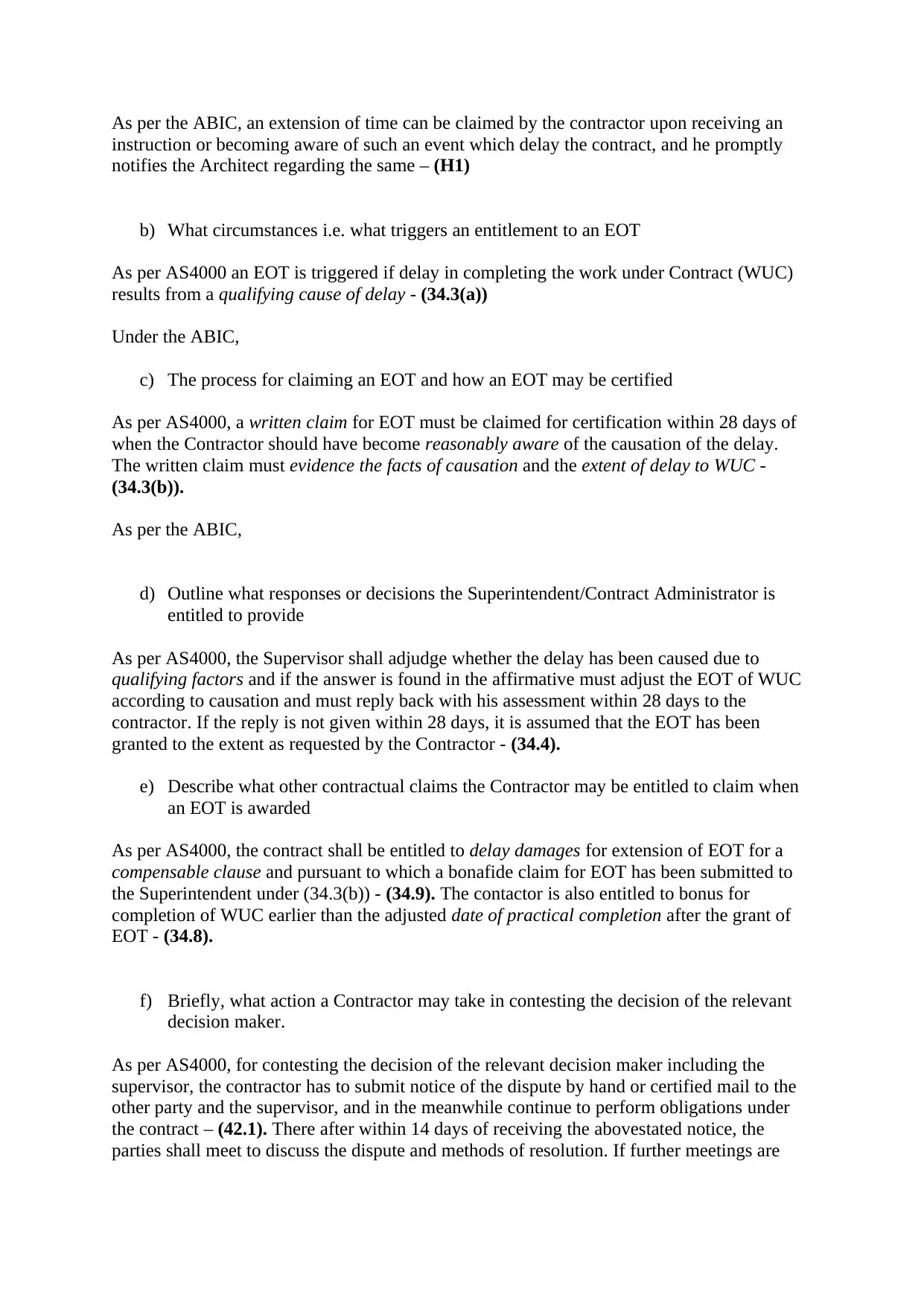
As per the ABIC, an extension of time can be claimed by the contractor upon receiving an
instruction or becoming aware of such an event which delay the contract, and he promptly
notifies the Architect regarding the same – (H1)
b) What circumstances i.e. what triggers an entitlement to an EOT
As per AS4000 an EOT is triggered if delay in completing the work under Contract (WUC)
results from a qualifying cause of delay - (34.3(a))
Under the ABIC,
c) The process for claiming an EOT and how an EOT may be certified
As per AS4000, a written claim for EOT must be claimed for certification within 28 days of
when the Contractor should have become reasonably aware of the causation of the delay.
The written claim must evidence the facts of causation and the extent of delay to WUC -
(34.3(b)).
As per the ABIC,
d) Outline what responses or decisions the Superintendent/Contract Administrator is
entitled to provide
As per AS4000, the Supervisor shall adjudge whether the delay has been caused due to
qualifying factors and if the answer is found in the affirmative must adjust the EOT of WUC
according to causation and must reply back with his assessment within 28 days to the
contractor. If the reply is not given within 28 days, it is assumed that the EOT has been
granted to the extent as requested by the Contractor - (34.4).
e) Describe what other contractual claims the Contractor may be entitled to claim when
an EOT is awarded
As per AS4000, the contract shall be entitled to delay damages for extension of EOT for a
compensable clause and pursuant to which a bonafide claim for EOT has been submitted to
the Superintendent under (34.3(b)) - (34.9). The contactor is also entitled to bonus for
completion of WUC earlier than the adjusted date of practical completion after the grant of
EOT - (34.8).
f) Briefly, what action a Contractor may take in contesting the decision of the relevant
decision maker.
As per AS4000, for contesting the decision of the relevant decision maker including the
supervisor, the contractor has to submit notice of the dispute by hand or certified mail to the
other party and the supervisor, and in the meanwhile continue to perform obligations under
the contract – (42.1). There after within 14 days of receiving the abovestated notice, the
parties shall meet to discuss the dispute and methods of resolution. If further meetings are
instruction or becoming aware of such an event which delay the contract, and he promptly
notifies the Architect regarding the same – (H1)
b) What circumstances i.e. what triggers an entitlement to an EOT
As per AS4000 an EOT is triggered if delay in completing the work under Contract (WUC)
results from a qualifying cause of delay - (34.3(a))
Under the ABIC,
c) The process for claiming an EOT and how an EOT may be certified
As per AS4000, a written claim for EOT must be claimed for certification within 28 days of
when the Contractor should have become reasonably aware of the causation of the delay.
The written claim must evidence the facts of causation and the extent of delay to WUC -
(34.3(b)).
As per the ABIC,
d) Outline what responses or decisions the Superintendent/Contract Administrator is
entitled to provide
As per AS4000, the Supervisor shall adjudge whether the delay has been caused due to
qualifying factors and if the answer is found in the affirmative must adjust the EOT of WUC
according to causation and must reply back with his assessment within 28 days to the
contractor. If the reply is not given within 28 days, it is assumed that the EOT has been
granted to the extent as requested by the Contractor - (34.4).
e) Describe what other contractual claims the Contractor may be entitled to claim when
an EOT is awarded
As per AS4000, the contract shall be entitled to delay damages for extension of EOT for a
compensable clause and pursuant to which a bonafide claim for EOT has been submitted to
the Superintendent under (34.3(b)) - (34.9). The contactor is also entitled to bonus for
completion of WUC earlier than the adjusted date of practical completion after the grant of
EOT - (34.8).
f) Briefly, what action a Contractor may take in contesting the decision of the relevant
decision maker.
As per AS4000, for contesting the decision of the relevant decision maker including the
supervisor, the contractor has to submit notice of the dispute by hand or certified mail to the
other party and the supervisor, and in the meanwhile continue to perform obligations under
the contract – (42.1). There after within 14 days of receiving the abovestated notice, the
parties shall meet to discuss the dispute and methods of resolution. If further meetings are

required, the parties may be represented by authorised representatives. If the dispute is not
solved within 28 days, it shall be referred to arbitration - (42.1).
solved within 28 days, it shall be referred to arbitration - (42.1).
⊘ This is a preview!⊘
Do you want full access?
Subscribe today to unlock all pages.

Trusted by 1+ million students worldwide
1 out of 6
Your All-in-One AI-Powered Toolkit for Academic Success.
+13062052269
info@desklib.com
Available 24*7 on WhatsApp / Email
![[object Object]](/_next/static/media/star-bottom.7253800d.svg)
Unlock your academic potential
Copyright © 2020–2025 A2Z Services. All Rights Reserved. Developed and managed by ZUCOL.
